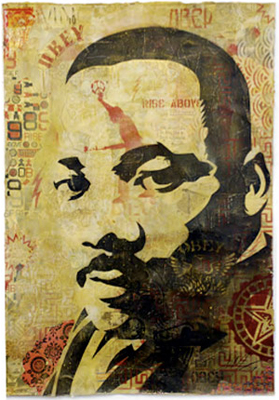Fair Use
A note on the ongoing Shepard Fairey Obama poster fair use debate:
Earlier this week, the Art Law blog posted the following question:

Shepard Fairey, *"MLK," 2007?
I do believe that transformation is an important element of fair use, although I suspect that I'm more liberal with my threshold for sufficiently transformed. However, I don't think it's a two-way street. Why not? Because, in my admittedly limited understanding, fair use exists to allow non-commercial uses of works without paying a fee. The sticking point for me is not really the issue of transformative, it's the issue of defining non-commercial intent. It seems obvious that someone selling mass produced "schwag" is there purely for commercial intent, but the line gets blurrier when you deal with an artist who is reusing images or sounds and might want to sell their work to a collector. Or, in the case of successful mash up artists like Girl Talk, thousands of fans.
Are we stuck, then, in that seemingly obvious yet logically indefensible realm, the arbitration of taste?
*I chose this image because you have all seen the Obama poster by now. This much more transformative and subtler image predates it.
Earlier this week, the Art Law blog posted the following question:
...This relates to a question I've been meaning to put to those who believe Fairey's was a fair use because of its "transformative purpose": would the argument work in the other direction? That is, assume a well-known photographer creates an image the purpose of which is to move people, express some idea, touch our souls. Now along comes a crass commercial artist who makes modest changes to the image along the lines of what Fairey did here, and then starts mass producing and selling posters of it. Now we have a totally different purpose -- to make boatloads of money. Fair use? Or is "transformation" a one-way street?

Shepard Fairey, *"MLK," 2007?
I do believe that transformation is an important element of fair use, although I suspect that I'm more liberal with my threshold for sufficiently transformed. However, I don't think it's a two-way street. Why not? Because, in my admittedly limited understanding, fair use exists to allow non-commercial uses of works without paying a fee. The sticking point for me is not really the issue of transformative, it's the issue of defining non-commercial intent. It seems obvious that someone selling mass produced "schwag" is there purely for commercial intent, but the line gets blurrier when you deal with an artist who is reusing images or sounds and might want to sell their work to a collector. Or, in the case of successful mash up artists like Girl Talk, thousands of fans.
Are we stuck, then, in that seemingly obvious yet logically indefensible realm, the arbitration of taste?
*I chose this image because you have all seen the Obama poster by now. This much more transformative and subtler image predates it.
Labels: art, fair use, intellectual property, music


0 Comments:
Post a Comment
<< Home